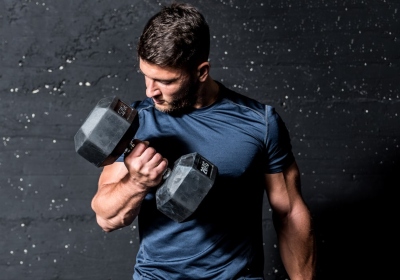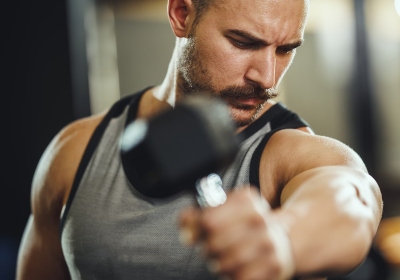VIDEO
Kettlebell Single Arm Bicep Curl
- Biceps
- Shoulders
Level:Intermediate
Trainer:Nick Taylor
Equipment:Kettlebell
Kettlebell Single Arm Bicep Curl
- Biceps
- Shoulders
Level:Intermediate
Trainer:Nick Taylor
Equipment:Kettlebell
Stand tall with your feet approximately shoulder-width apart. Grab a kettlebell in one hand. And without moving your upper arms slowly curl the weight up until the kettlebell reach your shoulder. Target your biceps and forearm and then slowly return your arms back to the starting position.
save to ...
RECOMMENDED FOR YOU
ARTICLES
Biceps is the most famous muscle in the human muscular system, it is approximately one-third of the mass of the shoulder. It is a part of a group of three in the upper arm that works together with each other to lift the arm toward the shoulder. As one of the most visible and impressive parts of the body, “two-headed muscles” are often the gym’s focus.
It is responsible for two main movements of the arm. The first is raising your hand. Those who carry something using their arm are likely to engage them in the process, as some upward force must be applied during the process of carrying and lifting. The second movement, for which they are responsible, is called supination, which rotates the arm from the natural position of the palm down to the palm up.
Biceps are built as a result of injury, which is often achieved through lifting weights such as curls or other types of exercises. As the curls or other exercises are done, the muscles in the arm get minor injuries. These injuries must be repaired naturally. The recovery process, as a natural byproduct, usually leads to growth and strength gains, although this process can take several weeks or months before noticeable results are seen.
Very few exercises work for it without affecting the other parts of the shoulder. Therefore, there is no reason to worry that others in the upper arm might be neglected by focusing on them. Some may focus only on the arm and almost completely forget about the legs or the core.
As one of the most commonly used muscles in the body, the biceps can certainly be damaged. Biceps injuries are not as common as some other types of injuries, there is always a risk, especially among weightlifters. The most common type of injury is damage to the tendon. In this type of injury, It is pulled away from the tendon that attaches it to the arm in a bone also known as the radius. Such injuries occur when they are used suddenly or to a level that they cannot handle.
Training.
Dumbbell Bicep Curls. Stand straight with the dumbbell in each hand and with your feet shoulder-width apart. Once the dumbbells are at your shoulder level, start slowly lower your arms to the starting position. Repeat for the desired amount of repetitions.
Incline Pushup. Place your hands slightly wider than shoulder-width apart on a bench, chair, or couch. And assume a high plank position with your feet together and your body straight from head to heels. Keeping your feet flat and core engaged lower your chest to the bench or chair. Pause. And then push yourself back up to the starting position.
Diamond Knee Pushup. With your knees on the ground place your hands on the ground with your fingers and thumbs touching together creating the diamond shape. This action will engage more your tricep muscle. Then complete a push-up and get back to the starting position. Repeat for the desired number of repetitions.
Pike Pushup. Assume a shorter push-up position, get on your toes and put your butt up, shifting your weights to the front. Bending your arms slowly lower your head, be sure not to bump your head on the ground.
Read more
The shoulder muscles are divided into two groups. The anterior group consists of flexors: the coracohumeral, the brachialis, and the biceps brachii. The posterior group includes the extensors: the triceps brachii and ulnar.
The coracohumerals start from the coracoid process of the scapula fuses with the short head of the biceps brachii and pectoralis minor and attaches to the humerus at the level of the upper edge of the brachial.
The brachials start from the lower half of the anterior surface of the humerus and the intermuscular septa of the shoulder and attach to the tuberosity of the ulna and its coronal process.
The biceps brachii has two heads starting on the scapula from the supra-articular tubercle (long head) and the coracoid process (short head). It attaches to the forearm to the tuberosity of the radius and the fascia of the forearm. It belongs to the bicarticular part. Concerning the shoulder joint, the biceps of the shoulder is the flexor of the shoulder, and the elbow is the flexor and instep support of the forearm.
The triceps brachii is located on the back of the shoulder, has three heads, and is a bicarticular. It participates in the movements of both the shoulder and the forearm, causing extension and adduction in the shoulder joint and extension in the elbow.
The ulnar starts from the lateral epicondyle of the humerus and radial collateral ligament and the fascia; it is attached to the upper part of the posterior surface and partly to the olecranon of the ulna in its upper quarter. The function of this is to extend the forearm.
The bundles of the deltoid muscle perform different functions, so it will not work to load them all with one exercise: you will have to include at least three movements in the training. All exercises are divided into three parts: for pumping the front, middle and back beams. Pick exercises from our list below and add them to your workouts. The weight is necessary so that the last repetitions in the approach are given not easily, but without compromising the technique. You can train your shoulder straps both at home and in the gym. But it is necessary to have a bar and a gantry. Weight must be chosen in such a way that in every set it was possible to raise the average 8-10 times. This is how you can increase the volume and mass. If the same goal is set - to increase the strength, to train in the face of more severe conditions. In this case, the number of repeats will be 5-8. The number of reps is 4-5.
Barbell bench press. Take the shell on your chest, bring your elbows forward, tighten your abs, buttocks, legs. Squeeze the bar up, lower it back and repeat. When the bar passes your face, do not lift your chin, but squeeze it in yourself: this way the bar will go along the optimal trajectory. If the projectile remains in front of the body at the top point, and not above it, the load on the lower back increases. Therefore, try to take the barbell behind your head.
Standing dumbbell press. Raise your arms with the selected weight to shoulder level, turn your palms forward with your fingers. Squeeze the dumbbells up and take them slightly behind your head, and then lower them to the starting position and repeat. Do three to five approaches 10-12 times.
Seated Bent-Over Dumbbell Routing. Sit on a bench, tilt your body with a straight back, as far as flexibility allows, hold the dumbbells in your lowered hands. Without changing the position of the body, spread your arms with the taken weight on the sides to shoulder level. Slowly lower the dumbbells to the starting position and repeat.
Read more
SAVE TO ...


